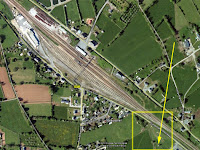When the German army swept over France in 1940 it found that the whole of the French west coast became its territory and that it could be useful to Navy’s U-boat fleet to extend its radius. Instead of having to negotiate the northern passage between Scotland and Norway, they would be able to use the French ports to rain free out into the Atlantic.
Above : 1924 Above : 1944
The channel was dredged, an incline added to allow the boats to be drawn up on to land, a turntable added and six repair facilities were placed like a clock around the turntable.
The channel was dredged, an incline added to allow the boats to be drawn up on to land, a turntable added and six repair facilities were placed like a clock around the turntable.
Whilst it was being built, bombing by the RAF and now the Americans had increased not just in quantity but also accuracy, so overhead protection was needed. There was a bunker used to protect large railway guns and this design could be adapted to take U-boats. A domed structure with a pointed roof to allow bombs to ricochet off rather than explode on, was built. 84meters long, a height of 25meters with a working length of 60meters. Allowing the smaller Type II Class boats to be serviced here.




















 ft
ft























